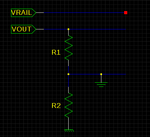rswarbrick
Newbie level 4
Hi,
I've got a sort of repair / mod project going with an old Weir 430 power supply. I want to replace the (broken) analogue meter with a pair of 4 digit displays. The power supply is specified at 0-30V, 0-3A so I decided to use a 12-bit dual ADC with a 4.096V reference (4096 count, so 1mA resolution). Getting 12 bit precision over (say) a 20°C range seems non-trivial in various ways, but I had one specific question:
The connections I'm going to have to my board have the following voltages (in increasing order)
My plan was to use a 9:1 potential divider to make a new ground reference at 90% of the output voltage. In order not to fry the ADC or some other digital parts, I would use a 5V regulator from the supply rail. Then there would be a precision InAmp to measure from the current shunt and some passives etc. The two voltages measured by the ADC would then be the output voltage rail (now 0-3V) and the difference from the InAmp, amplified with a gain of 4 to give it the same range.
Problem is, that presumably current going to ground will cause a greater voltage drop across part of the potential divider, messing up the voltage measurement. Am I right in expecting this and (more importantly!) how do people usually get around this?
Also, I presume that to get anywhere near the required precision, I'll need to use some sort of array for this divider. I'd guess I should use a part like this one from Susumu (link to Digikey product page). Is this the right idea?
Many thanks,
Rupert
I've got a sort of repair / mod project going with an old Weir 430 power supply. I want to replace the (broken) analogue meter with a pair of 4 digit displays. The power supply is specified at 0-30V, 0-3A so I decided to use a 12-bit dual ADC with a 4.096V reference (4096 count, so 1mA resolution). Getting 12 bit precision over (say) a 20°C range seems non-trivial in various ways, but I had one specific question:
The connections I'm going to have to my board have the following voltages (in increasing order)
- Case Ground (0V)
- Output Voltage (0-30V)
- Above current shunt (0-30.75V)
- Internal supply rail (6.8 - 36.8V)
My plan was to use a 9:1 potential divider to make a new ground reference at 90% of the output voltage. In order not to fry the ADC or some other digital parts, I would use a 5V regulator from the supply rail. Then there would be a precision InAmp to measure from the current shunt and some passives etc. The two voltages measured by the ADC would then be the output voltage rail (now 0-3V) and the difference from the InAmp, amplified with a gain of 4 to give it the same range.
Problem is, that presumably current going to ground will cause a greater voltage drop across part of the potential divider, messing up the voltage measurement. Am I right in expecting this and (more importantly!) how do people usually get around this?
Also, I presume that to get anywhere near the required precision, I'll need to use some sort of array for this divider. I'd guess I should use a part like this one from Susumu (link to Digikey product page). Is this the right idea?
Many thanks,
Rupert
